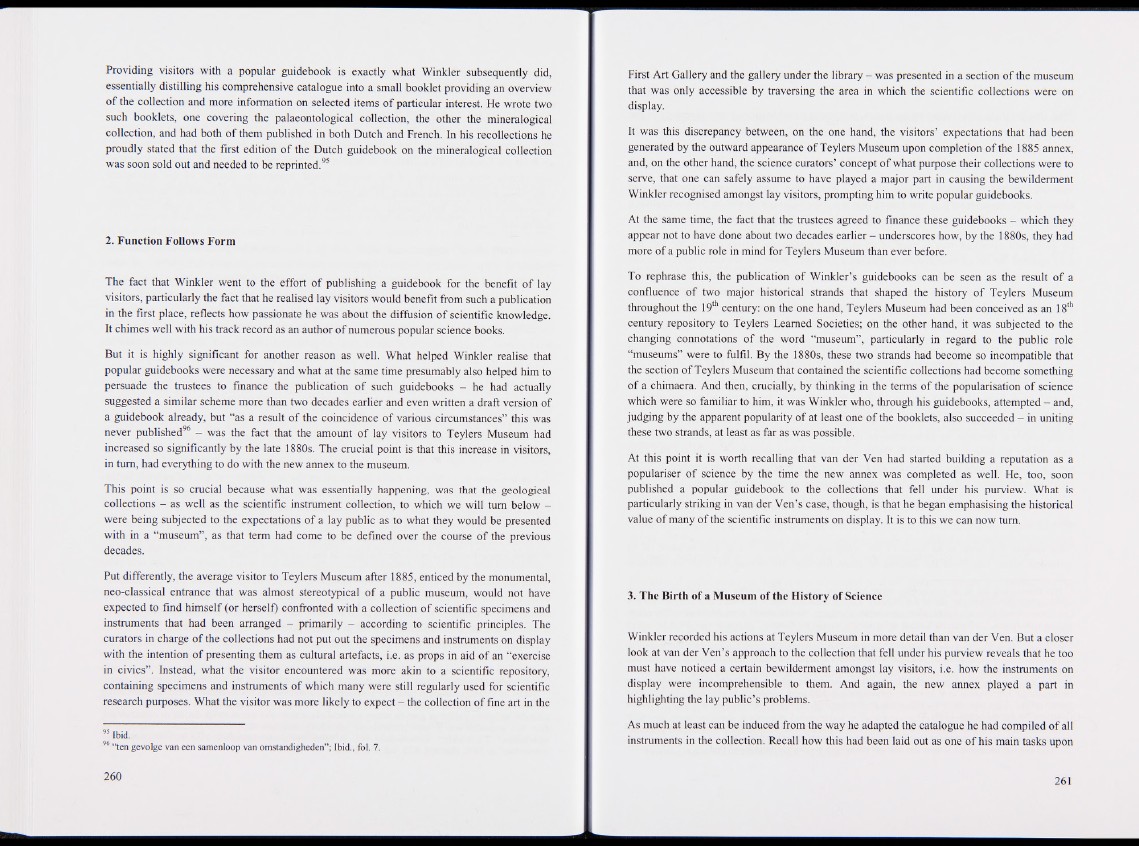
Providing visitors with a popular guidebook is exactly what Winkler subsequently did,
essentially distilling his comprehensive catalogue into a small booklet providing an overview
of the collection and more information on selected items of particular interest. He wrote two
such booklets, one covering the palaeontological collection, the other the mineralogical
collection, and had both of them published in both Dutch and French. In his recollections he
proudly stated that the first edition of the Dutch guidebook on the mineralogical collection
was soon sold out and needed to be reprinted.95
2. Function Follows Form
The fact that Winkler went to the effort of publishing a guidebook for the benefit of lay
visitors, particularly the fact that he realised lay visitors would benefit from such a publication
in the first place, reflects how passionate he was about the diffusion of scientific knowledge.
It chimes well with his track record as an author of numerous popular science books.
But it is highly significant for another reason as well. What helped Winkler realise that
popular guidebooks were necessary and what at the same time presumably also helped him to
persuade the trustees to finance the publication of such guidebooks I he had actually
suggested a similar scheme more than two decades earlier and even written a draft version of
a guidebook already, but “as a result of the coincidence of various circumstances” this was
never published96 - was the fact that the amount of lay visitors to Teylers Museum had
increased so significantly by the late 1880s. The crucial point is that this increase in visitors,
in turn, had everything to do with the new annex to the museum.
This point is so crucial because what was essentially happening, was that the geological
collectionsE as well as the scientific instrument collection, to which we will turn below -
were being subjected to the expectations of a lay public as to what they would be presented
with in a “museum”, as that term had come to be defined over the course of the previous
decades.
Put differently, the average visitor to Teylers Museum after 1885, enticed by the monumental,
neo-classical entrance that was almost stereotypical of a public museum, would not have
expected to find himself (or herself) confronted with a collection of scientific specimens and
instruments that had been arranged,» primarily - according to scientific principles. The
curators in charge of the collections had not put out the specimens and instruments on display
with the intention of presenting them as cultural artefacts, i.e. as props in aid of an “exercise
in civics”. Instead, what the visitor encountered was more akin to a scientific repository,
containing specimens and instruments of which many were still regularly used for scientific
research purposes. What the visitor was more likely to expect - the collection of fine art in the
95 Ibid.
96 “ten gevolge van een samenloop van omstandigheden”; Ibid., fol. 7.
First Art Gallery and the gallery under the library - was presented in a section of the museum
that was only accessible by traversing the area in which the scientific collections were on
display.
It was this discrepancy between, on the one hand, the visitors’ expectations that had been
generated by the outward appearance of Teylers Museum upon completion of the 1885 annex,
and, on the other hand, the science curators’ concept of what purpose their collections were to
serve, that one can safely assume to have played a major part in causing the bewilderment
Winkler recognised amongst lay visitors, prompting him to write popular guidebooks.
At the same time, the fact that the trustees agreed to finance these guidebooks - which they
appear not to have done about two decades earlier - underscores how, by the 1880s, they had
more of a public role in mind for Teylers Museum than ever before.
To rephrase this, the publication of Winkler’s guidebooks can be seen as the result of a
confluence of two major historical strands that shaped the history of Teylers Museum
throughout the 19th century: on the one hand, Teylers Museum had been conceived as an 18th
century repository to Teylers Learned Societies; on the other hand, it was subjected to the
changing connotations of the word “museum”, particularly in regard to the public role
“museums” were to fulfil. By the 1880s, these two strands had become so incompatible that
the section of Teylers Museum that contained the scientific collections had become something
of a chimaera. And then, crucially, by thinking in the terms of the popularisation of science
which were so familiar to him, it was Winkler who, through his guidebooks, attempted *- and,
judging by the apparent popularity of at least one of the booklets, also succeeded p in uniting
these two strands, at least as far as was possible.
At this point it is worth recalling that van der Ven had started building a reputation as a
populariser of science by the time the new annex was completed as well. He, too, soon
published a popular guidebook to the collections that fell under his purview. What is
particularly striking in van der Ven’s case, though, is that he began emphasising the historical
value of many of the scientific instruments on display. It is to this we can now turn.
3. The Birth of a Museum of the History of Science
Winkler recorded his actions at Teylers Museum in more detail than van der Ven. But a closer
look at van der Ven’s approach to the collection that fell under his purview reveals that he too
must have noticed a certain bewilderment amongst lay visitors, i.e. how the instruments on
display were incomprehensible to them. And again, the new annex played a part in
highlighting the lay public’s problems.
As much at least can be induced from the way he adapted the catalogue he had compiled of all
instruments in the collection. Recall how this had been laid out as one of his main tasks upon